Problem Solving and Business Reporting Research Report Analysis
VerifiedAdded on 2023/06/08
|24
|6115
|217
Report
AI Summary
This report delves into the critical appraisal of various research methodologies essential for identifying and solving business problems, with a specific focus on the UAE business environment. It begins with an analysis of strategic and operational strengths and weaknesses using the SWOT analysis technique, examining sectors like finance and healthcare. The report then explores problem-structuring methods, including the scientific and systems approaches, and applies problem analysis techniques such as cause-and-effect analysis and Business Process Re-engineering (BPR) to specific business issues. The relevance and usability of these methods are evaluated through case studies, highlighting their application in integrating information, forecasting demands, and managing asset liability risks. The report emphasizes the importance of research in addressing past, present, and future business challenges, ensuring effective problem-solving and reporting practices.
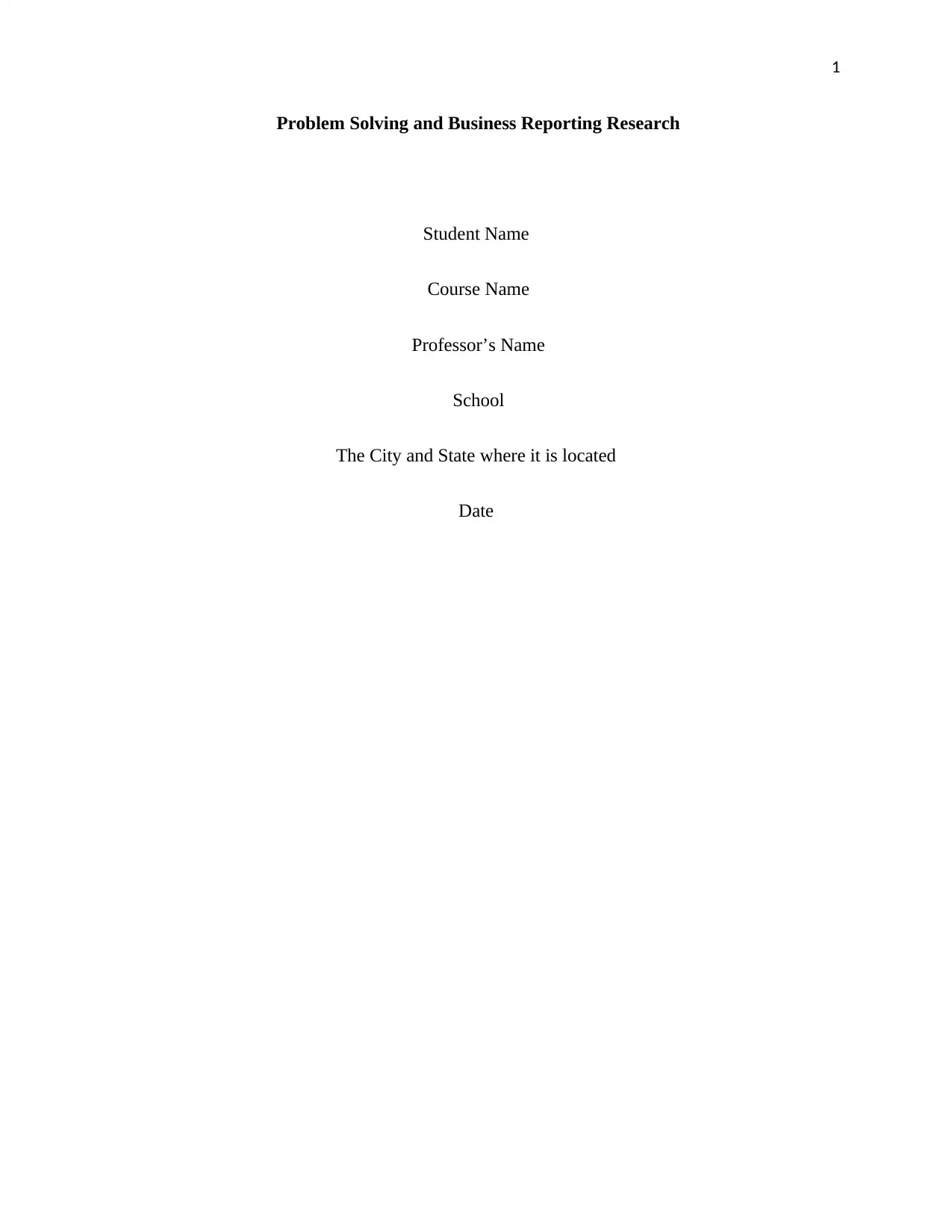
1
Problem Solving and Business Reporting Research
Student Name
Course Name
Professor’s Name
School
The City and State where it is located
Date
Problem Solving and Business Reporting Research
Student Name
Course Name
Professor’s Name
School
The City and State where it is located
Date
Paraphrase This Document
Need a fresh take? Get an instant paraphrase of this document with our AI Paraphraser
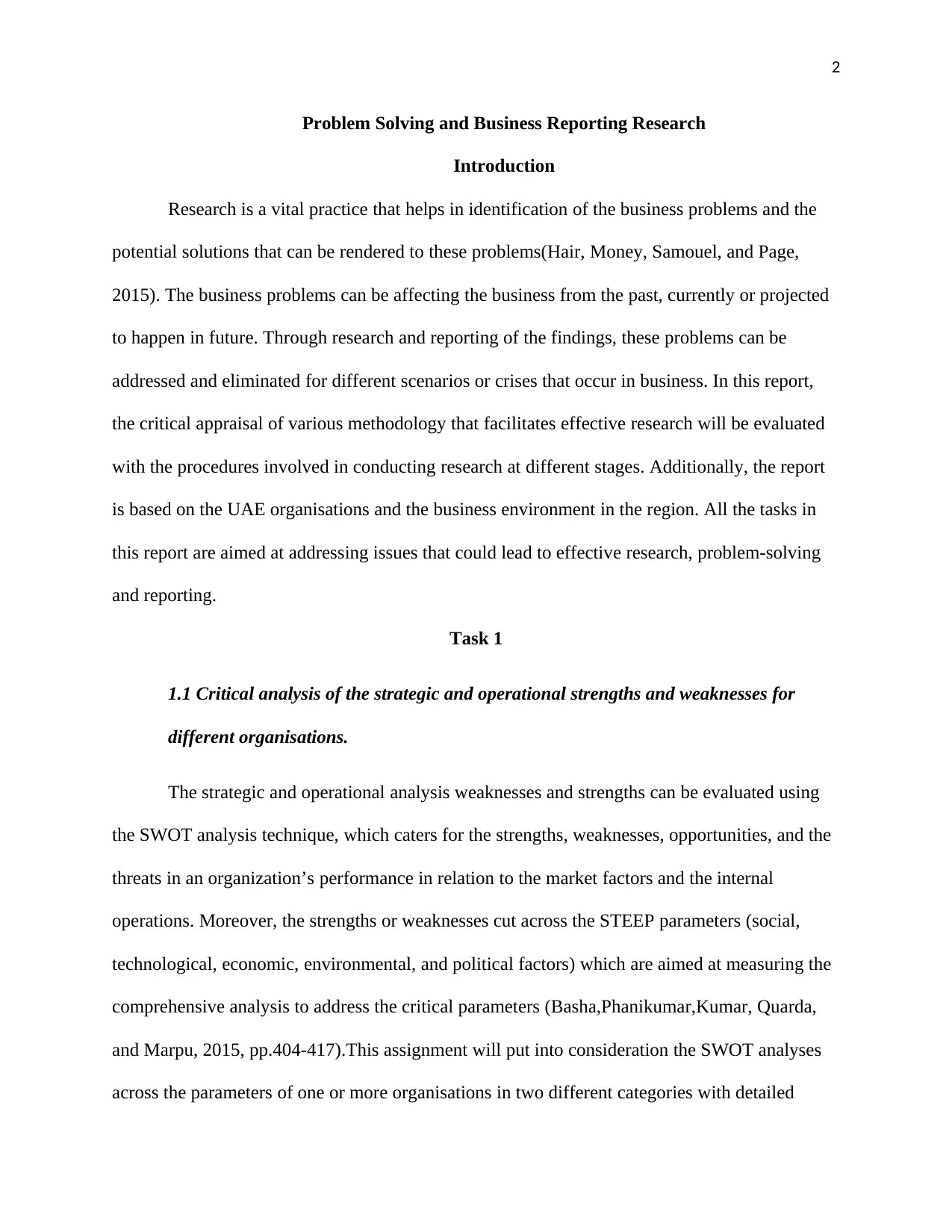
2
Problem Solving and Business Reporting Research
Introduction
Research is a vital practice that helps in identification of the business problems and the
potential solutions that can be rendered to these problems(Hair, Money, Samouel, and Page,
2015). The business problems can be affecting the business from the past, currently or projected
to happen in future. Through research and reporting of the findings, these problems can be
addressed and eliminated for different scenarios or crises that occur in business. In this report,
the critical appraisal of various methodology that facilitates effective research will be evaluated
with the procedures involved in conducting research at different stages. Additionally, the report
is based on the UAE organisations and the business environment in the region. All the tasks in
this report are aimed at addressing issues that could lead to effective research, problem-solving
and reporting.
Task 1
1.1 Critical analysis of the strategic and operational strengths and weaknesses for
different organisations.
The strategic and operational analysis weaknesses and strengths can be evaluated using
the SWOT analysis technique, which caters for the strengths, weaknesses, opportunities, and the
threats in an organization’s performance in relation to the market factors and the internal
operations. Moreover, the strengths or weaknesses cut across the STEEP parameters (social,
technological, economic, environmental, and political factors) which are aimed at measuring the
comprehensive analysis to address the critical parameters (Basha,Phanikumar,Kumar, Quarda,
and Marpu, 2015, pp.404-417).This assignment will put into consideration the SWOT analyses
across the parameters of one or more organisations in two different categories with detailed
Problem Solving and Business Reporting Research
Introduction
Research is a vital practice that helps in identification of the business problems and the
potential solutions that can be rendered to these problems(Hair, Money, Samouel, and Page,
2015). The business problems can be affecting the business from the past, currently or projected
to happen in future. Through research and reporting of the findings, these problems can be
addressed and eliminated for different scenarios or crises that occur in business. In this report,
the critical appraisal of various methodology that facilitates effective research will be evaluated
with the procedures involved in conducting research at different stages. Additionally, the report
is based on the UAE organisations and the business environment in the region. All the tasks in
this report are aimed at addressing issues that could lead to effective research, problem-solving
and reporting.
Task 1
1.1 Critical analysis of the strategic and operational strengths and weaknesses for
different organisations.
The strategic and operational analysis weaknesses and strengths can be evaluated using
the SWOT analysis technique, which caters for the strengths, weaknesses, opportunities, and the
threats in an organization’s performance in relation to the market factors and the internal
operations. Moreover, the strengths or weaknesses cut across the STEEP parameters (social,
technological, economic, environmental, and political factors) which are aimed at measuring the
comprehensive analysis to address the critical parameters (Basha,Phanikumar,Kumar, Quarda,
and Marpu, 2015, pp.404-417).This assignment will put into consideration the SWOT analyses
across the parameters of one or more organisations in two different categories with detailed
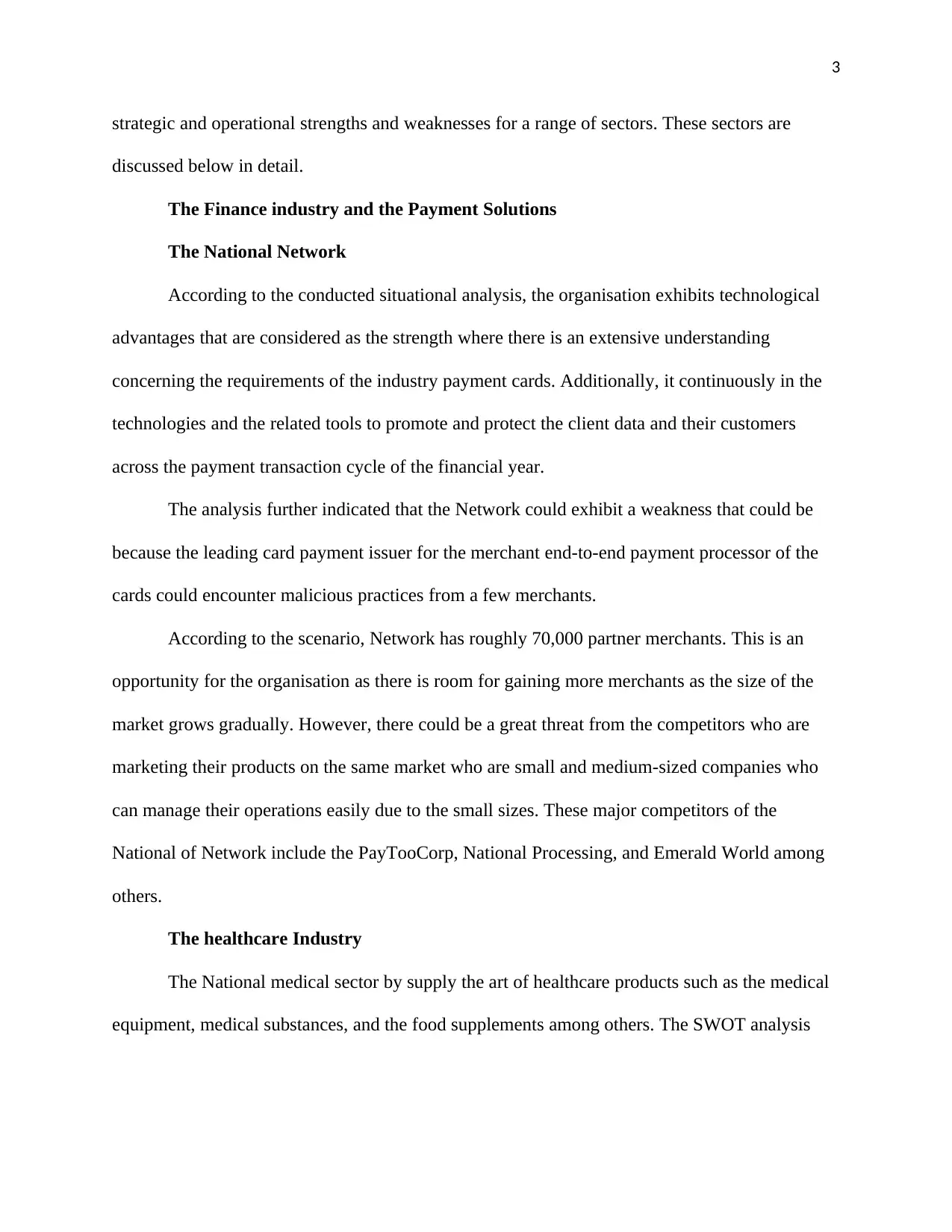
3
strategic and operational strengths and weaknesses for a range of sectors. These sectors are
discussed below in detail.
The Finance industry and the Payment Solutions
The National Network
According to the conducted situational analysis, the organisation exhibits technological
advantages that are considered as the strength where there is an extensive understanding
concerning the requirements of the industry payment cards. Additionally, it continuously in the
technologies and the related tools to promote and protect the client data and their customers
across the payment transaction cycle of the financial year.
The analysis further indicated that the Network could exhibit a weakness that could be
because the leading card payment issuer for the merchant end-to-end payment processor of the
cards could encounter malicious practices from a few merchants.
According to the scenario, Network has roughly 70,000 partner merchants. This is an
opportunity for the organisation as there is room for gaining more merchants as the size of the
market grows gradually. However, there could be a great threat from the competitors who are
marketing their products on the same market who are small and medium-sized companies who
can manage their operations easily due to the small sizes. These major competitors of the
National of Network include the PayTooCorp, National Processing, and Emerald World among
others.
The healthcare Industry
The National medical sector by supply the art of healthcare products such as the medical
equipment, medical substances, and the food supplements among others. The SWOT analysis
strategic and operational strengths and weaknesses for a range of sectors. These sectors are
discussed below in detail.
The Finance industry and the Payment Solutions
The National Network
According to the conducted situational analysis, the organisation exhibits technological
advantages that are considered as the strength where there is an extensive understanding
concerning the requirements of the industry payment cards. Additionally, it continuously in the
technologies and the related tools to promote and protect the client data and their customers
across the payment transaction cycle of the financial year.
The analysis further indicated that the Network could exhibit a weakness that could be
because the leading card payment issuer for the merchant end-to-end payment processor of the
cards could encounter malicious practices from a few merchants.
According to the scenario, Network has roughly 70,000 partner merchants. This is an
opportunity for the organisation as there is room for gaining more merchants as the size of the
market grows gradually. However, there could be a great threat from the competitors who are
marketing their products on the same market who are small and medium-sized companies who
can manage their operations easily due to the small sizes. These major competitors of the
National of Network include the PayTooCorp, National Processing, and Emerald World among
others.
The healthcare Industry
The National medical sector by supply the art of healthcare products such as the medical
equipment, medical substances, and the food supplements among others. The SWOT analysis
⊘ This is a preview!⊘
Do you want full access?
Subscribe today to unlock all pages.

Trusted by 1+ million students worldwide
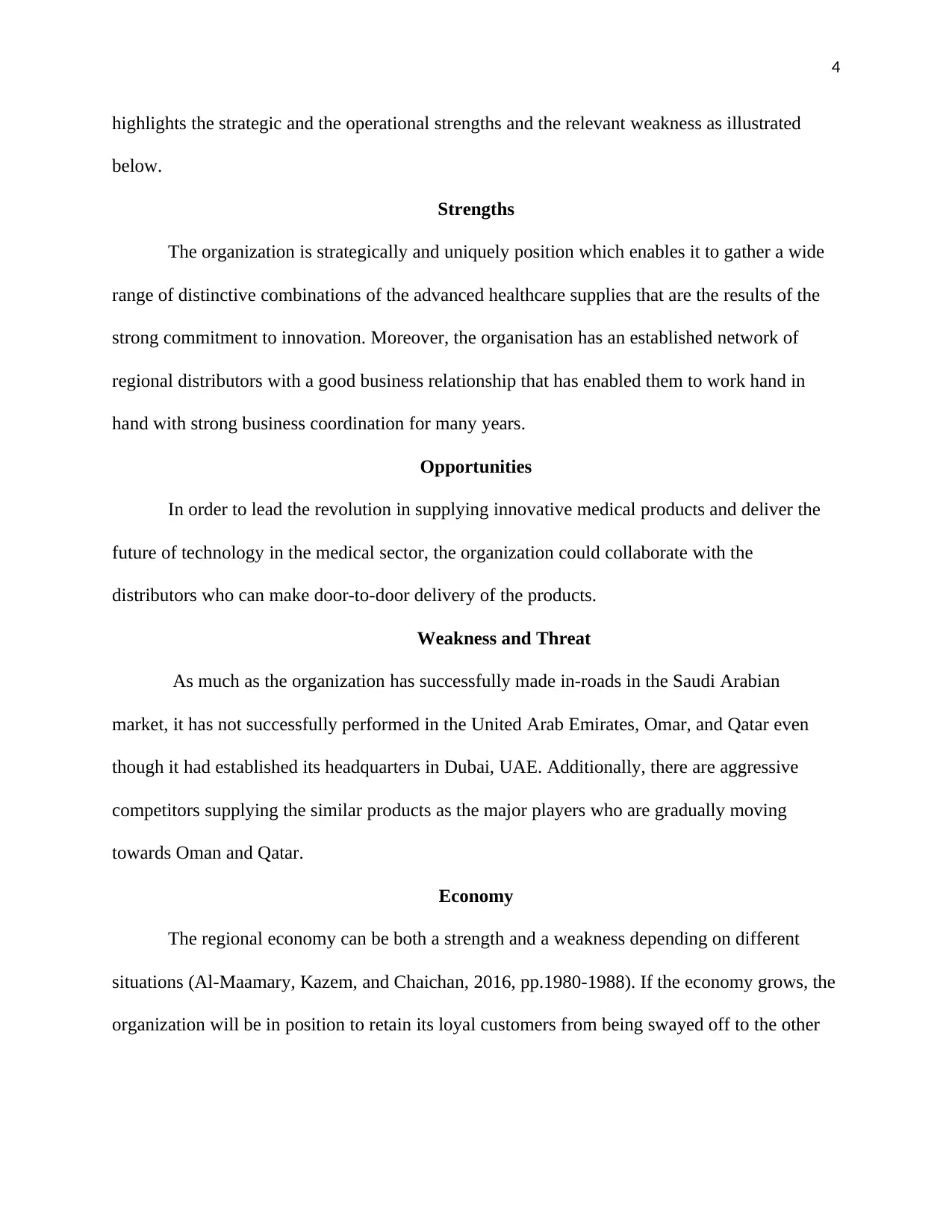
4
highlights the strategic and the operational strengths and the relevant weakness as illustrated
below.
Strengths
The organization is strategically and uniquely position which enables it to gather a wide
range of distinctive combinations of the advanced healthcare supplies that are the results of the
strong commitment to innovation. Moreover, the organisation has an established network of
regional distributors with a good business relationship that has enabled them to work hand in
hand with strong business coordination for many years.
Opportunities
In order to lead the revolution in supplying innovative medical products and deliver the
future of technology in the medical sector, the organization could collaborate with the
distributors who can make door-to-door delivery of the products.
Weakness and Threat
As much as the organization has successfully made in-roads in the Saudi Arabian
market, it has not successfully performed in the United Arab Emirates, Omar, and Qatar even
though it had established its headquarters in Dubai, UAE. Additionally, there are aggressive
competitors supplying the similar products as the major players who are gradually moving
towards Oman and Qatar.
Economy
The regional economy can be both a strength and a weakness depending on different
situations (Al-Maamary, Kazem, and Chaichan, 2016, pp.1980-1988). If the economy grows, the
organization will be in position to retain its loyal customers from being swayed off to the other
highlights the strategic and the operational strengths and the relevant weakness as illustrated
below.
Strengths
The organization is strategically and uniquely position which enables it to gather a wide
range of distinctive combinations of the advanced healthcare supplies that are the results of the
strong commitment to innovation. Moreover, the organisation has an established network of
regional distributors with a good business relationship that has enabled them to work hand in
hand with strong business coordination for many years.
Opportunities
In order to lead the revolution in supplying innovative medical products and deliver the
future of technology in the medical sector, the organization could collaborate with the
distributors who can make door-to-door delivery of the products.
Weakness and Threat
As much as the organization has successfully made in-roads in the Saudi Arabian
market, it has not successfully performed in the United Arab Emirates, Omar, and Qatar even
though it had established its headquarters in Dubai, UAE. Additionally, there are aggressive
competitors supplying the similar products as the major players who are gradually moving
towards Oman and Qatar.
Economy
The regional economy can be both a strength and a weakness depending on different
situations (Al-Maamary, Kazem, and Chaichan, 2016, pp.1980-1988). If the economy grows, the
organization will be in position to retain its loyal customers from being swayed off to the other
Paraphrase This Document
Need a fresh take? Get an instant paraphrase of this document with our AI Paraphraser
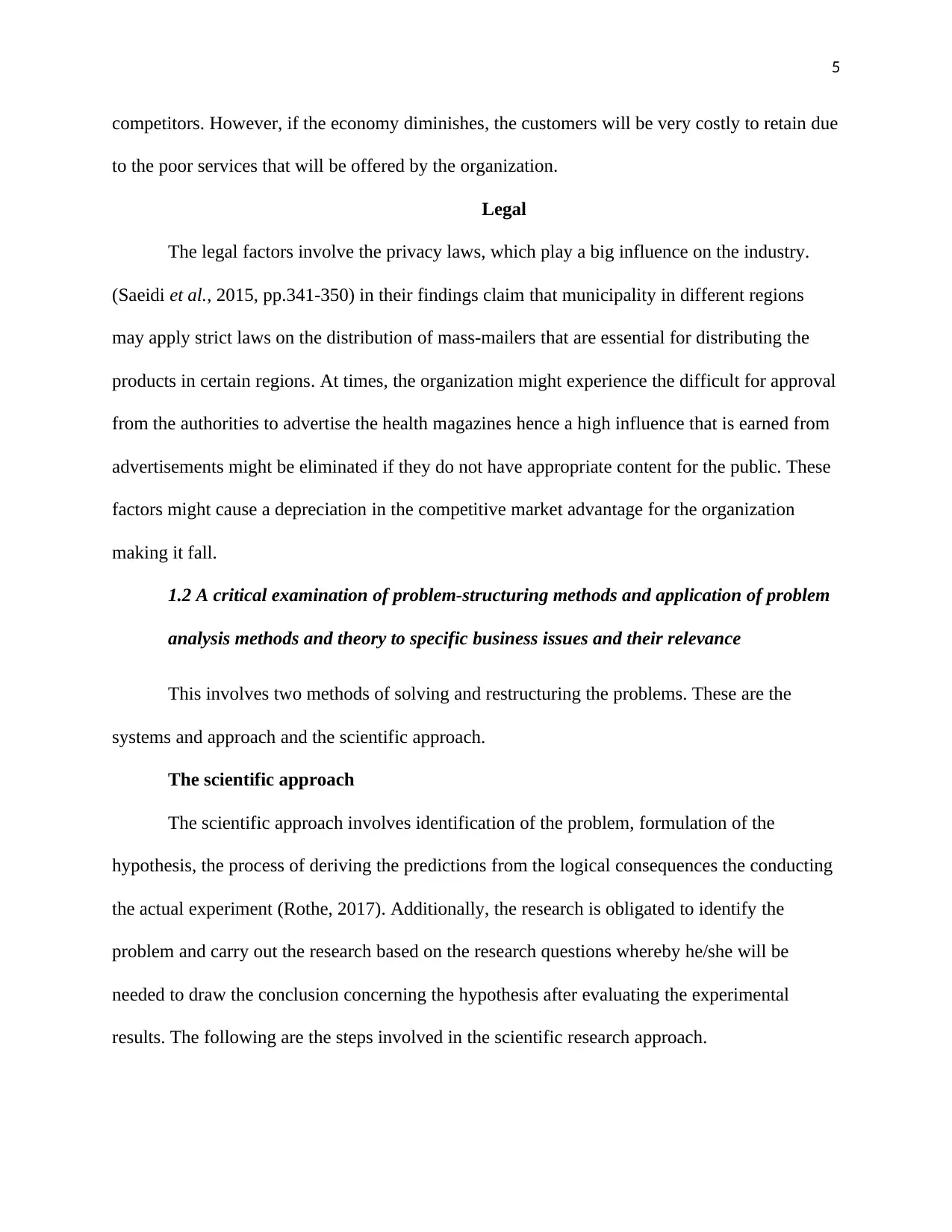
5
competitors. However, if the economy diminishes, the customers will be very costly to retain due
to the poor services that will be offered by the organization.
Legal
The legal factors involve the privacy laws, which play a big influence on the industry.
(Saeidi et al., 2015, pp.341-350) in their findings claim that municipality in different regions
may apply strict laws on the distribution of mass-mailers that are essential for distributing the
products in certain regions. At times, the organization might experience the difficult for approval
from the authorities to advertise the health magazines hence a high influence that is earned from
advertisements might be eliminated if they do not have appropriate content for the public. These
factors might cause a depreciation in the competitive market advantage for the organization
making it fall.
1.2 A critical examination of problem-structuring methods and application of problem
analysis methods and theory to specific business issues and their relevance
This involves two methods of solving and restructuring the problems. These are the
systems and approach and the scientific approach.
The scientific approach
The scientific approach involves identification of the problem, formulation of the
hypothesis, the process of deriving the predictions from the logical consequences the conducting
the actual experiment (Rothe, 2017). Additionally, the research is obligated to identify the
problem and carry out the research based on the research questions whereby he/she will be
needed to draw the conclusion concerning the hypothesis after evaluating the experimental
results. The following are the steps involved in the scientific research approach.
competitors. However, if the economy diminishes, the customers will be very costly to retain due
to the poor services that will be offered by the organization.
Legal
The legal factors involve the privacy laws, which play a big influence on the industry.
(Saeidi et al., 2015, pp.341-350) in their findings claim that municipality in different regions
may apply strict laws on the distribution of mass-mailers that are essential for distributing the
products in certain regions. At times, the organization might experience the difficult for approval
from the authorities to advertise the health magazines hence a high influence that is earned from
advertisements might be eliminated if they do not have appropriate content for the public. These
factors might cause a depreciation in the competitive market advantage for the organization
making it fall.
1.2 A critical examination of problem-structuring methods and application of problem
analysis methods and theory to specific business issues and their relevance
This involves two methods of solving and restructuring the problems. These are the
systems and approach and the scientific approach.
The scientific approach
The scientific approach involves identification of the problem, formulation of the
hypothesis, the process of deriving the predictions from the logical consequences the conducting
the actual experiment (Rothe, 2017). Additionally, the research is obligated to identify the
problem and carry out the research based on the research questions whereby he/she will be
needed to draw the conclusion concerning the hypothesis after evaluating the experimental
results. The following are the steps involved in the scientific research approach.
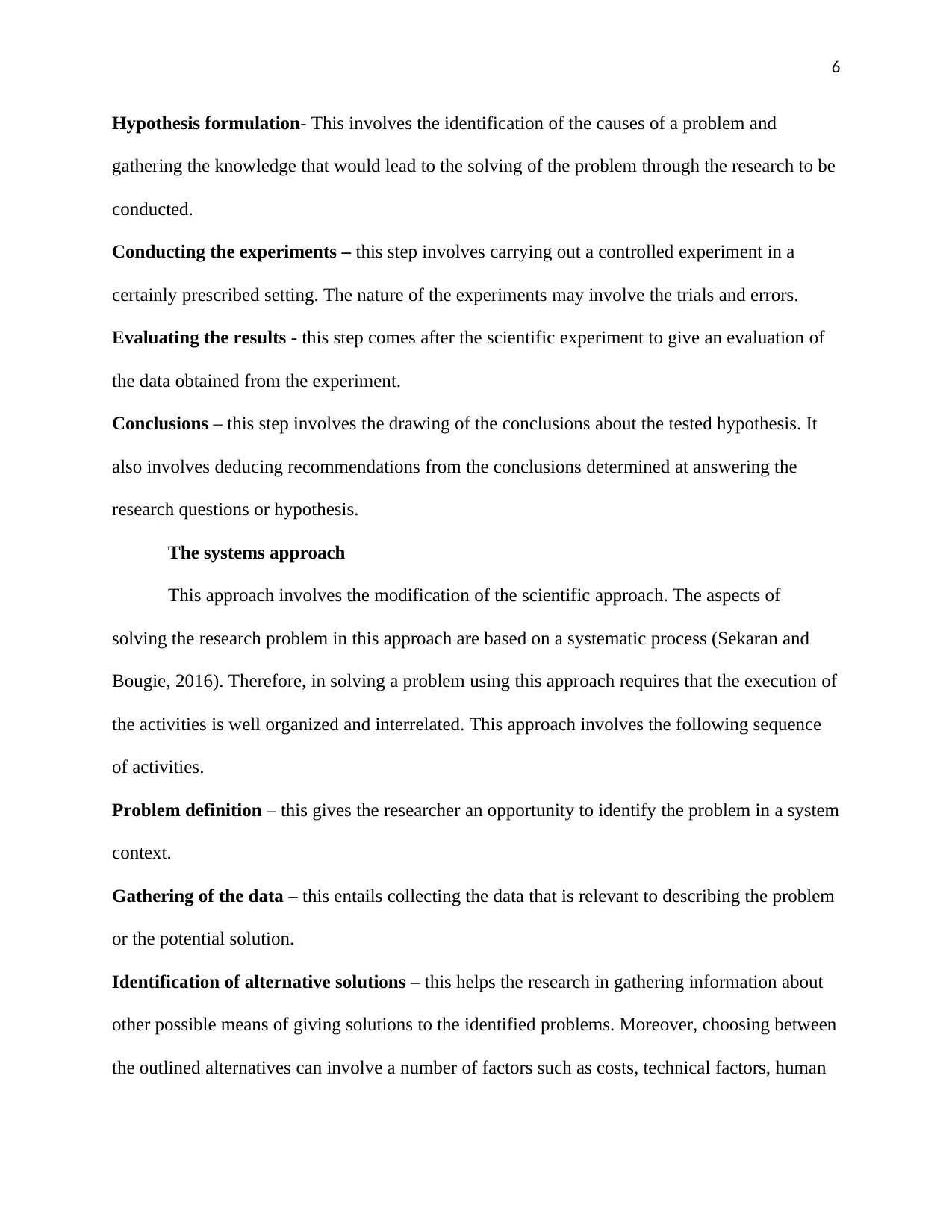
6
Hypothesis formulation- This involves the identification of the causes of a problem and
gathering the knowledge that would lead to the solving of the problem through the research to be
conducted.
Conducting the experiments – this step involves carrying out a controlled experiment in a
certainly prescribed setting. The nature of the experiments may involve the trials and errors.
Evaluating the results - this step comes after the scientific experiment to give an evaluation of
the data obtained from the experiment.
Conclusions – this step involves the drawing of the conclusions about the tested hypothesis. It
also involves deducing recommendations from the conclusions determined at answering the
research questions or hypothesis.
The systems approach
This approach involves the modification of the scientific approach. The aspects of
solving the research problem in this approach are based on a systematic process (Sekaran and
Bougie, 2016). Therefore, in solving a problem using this approach requires that the execution of
the activities is well organized and interrelated. This approach involves the following sequence
of activities.
Problem definition – this gives the researcher an opportunity to identify the problem in a system
context.
Gathering of the data – this entails collecting the data that is relevant to describing the problem
or the potential solution.
Identification of alternative solutions – this helps the research in gathering information about
other possible means of giving solutions to the identified problems. Moreover, choosing between
the outlined alternatives can involve a number of factors such as costs, technical factors, human
Hypothesis formulation- This involves the identification of the causes of a problem and
gathering the knowledge that would lead to the solving of the problem through the research to be
conducted.
Conducting the experiments – this step involves carrying out a controlled experiment in a
certainly prescribed setting. The nature of the experiments may involve the trials and errors.
Evaluating the results - this step comes after the scientific experiment to give an evaluation of
the data obtained from the experiment.
Conclusions – this step involves the drawing of the conclusions about the tested hypothesis. It
also involves deducing recommendations from the conclusions determined at answering the
research questions or hypothesis.
The systems approach
This approach involves the modification of the scientific approach. The aspects of
solving the research problem in this approach are based on a systematic process (Sekaran and
Bougie, 2016). Therefore, in solving a problem using this approach requires that the execution of
the activities is well organized and interrelated. This approach involves the following sequence
of activities.
Problem definition – this gives the researcher an opportunity to identify the problem in a system
context.
Gathering of the data – this entails collecting the data that is relevant to describing the problem
or the potential solution.
Identification of alternative solutions – this helps the research in gathering information about
other possible means of giving solutions to the identified problems. Moreover, choosing between
the outlined alternatives can involve a number of factors such as costs, technical factors, human
⊘ This is a preview!⊘
Do you want full access?
Subscribe today to unlock all pages.

Trusted by 1+ million students worldwide
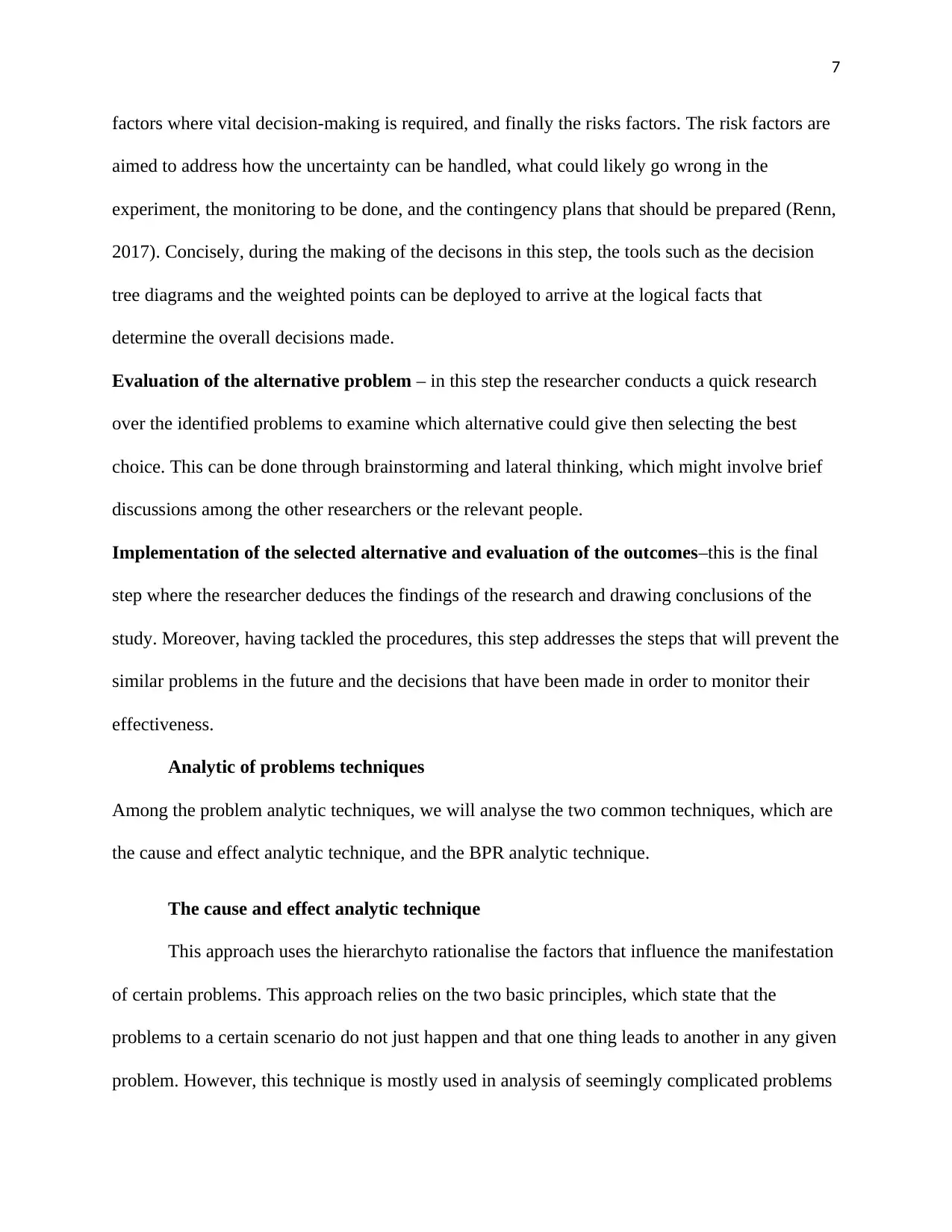
7
factors where vital decision-making is required, and finally the risks factors. The risk factors are
aimed to address how the uncertainty can be handled, what could likely go wrong in the
experiment, the monitoring to be done, and the contingency plans that should be prepared (Renn,
2017). Concisely, during the making of the decisons in this step, the tools such as the decision
tree diagrams and the weighted points can be deployed to arrive at the logical facts that
determine the overall decisions made.
Evaluation of the alternative problem – in this step the researcher conducts a quick research
over the identified problems to examine which alternative could give then selecting the best
choice. This can be done through brainstorming and lateral thinking, which might involve brief
discussions among the other researchers or the relevant people.
Implementation of the selected alternative and evaluation of the outcomes–this is the final
step where the researcher deduces the findings of the research and drawing conclusions of the
study. Moreover, having tackled the procedures, this step addresses the steps that will prevent the
similar problems in the future and the decisions that have been made in order to monitor their
effectiveness.
Analytic of problems techniques
Among the problem analytic techniques, we will analyse the two common techniques, which are
the cause and effect analytic technique, and the BPR analytic technique.
The cause and effect analytic technique
This approach uses the hierarchyto rationalise the factors that influence the manifestation
of certain problems. This approach relies on the two basic principles, which state that the
problems to a certain scenario do not just happen and that one thing leads to another in any given
problem. However, this technique is mostly used in analysis of seemingly complicated problems
factors where vital decision-making is required, and finally the risks factors. The risk factors are
aimed to address how the uncertainty can be handled, what could likely go wrong in the
experiment, the monitoring to be done, and the contingency plans that should be prepared (Renn,
2017). Concisely, during the making of the decisons in this step, the tools such as the decision
tree diagrams and the weighted points can be deployed to arrive at the logical facts that
determine the overall decisions made.
Evaluation of the alternative problem – in this step the researcher conducts a quick research
over the identified problems to examine which alternative could give then selecting the best
choice. This can be done through brainstorming and lateral thinking, which might involve brief
discussions among the other researchers or the relevant people.
Implementation of the selected alternative and evaluation of the outcomes–this is the final
step where the researcher deduces the findings of the research and drawing conclusions of the
study. Moreover, having tackled the procedures, this step addresses the steps that will prevent the
similar problems in the future and the decisions that have been made in order to monitor their
effectiveness.
Analytic of problems techniques
Among the problem analytic techniques, we will analyse the two common techniques, which are
the cause and effect analytic technique, and the BPR analytic technique.
The cause and effect analytic technique
This approach uses the hierarchyto rationalise the factors that influence the manifestation
of certain problems. This approach relies on the two basic principles, which state that the
problems to a certain scenario do not just happen and that one thing leads to another in any given
problem. However, this technique is mostly used in analysis of seemingly complicated problems
Paraphrase This Document
Need a fresh take? Get an instant paraphrase of this document with our AI Paraphraser
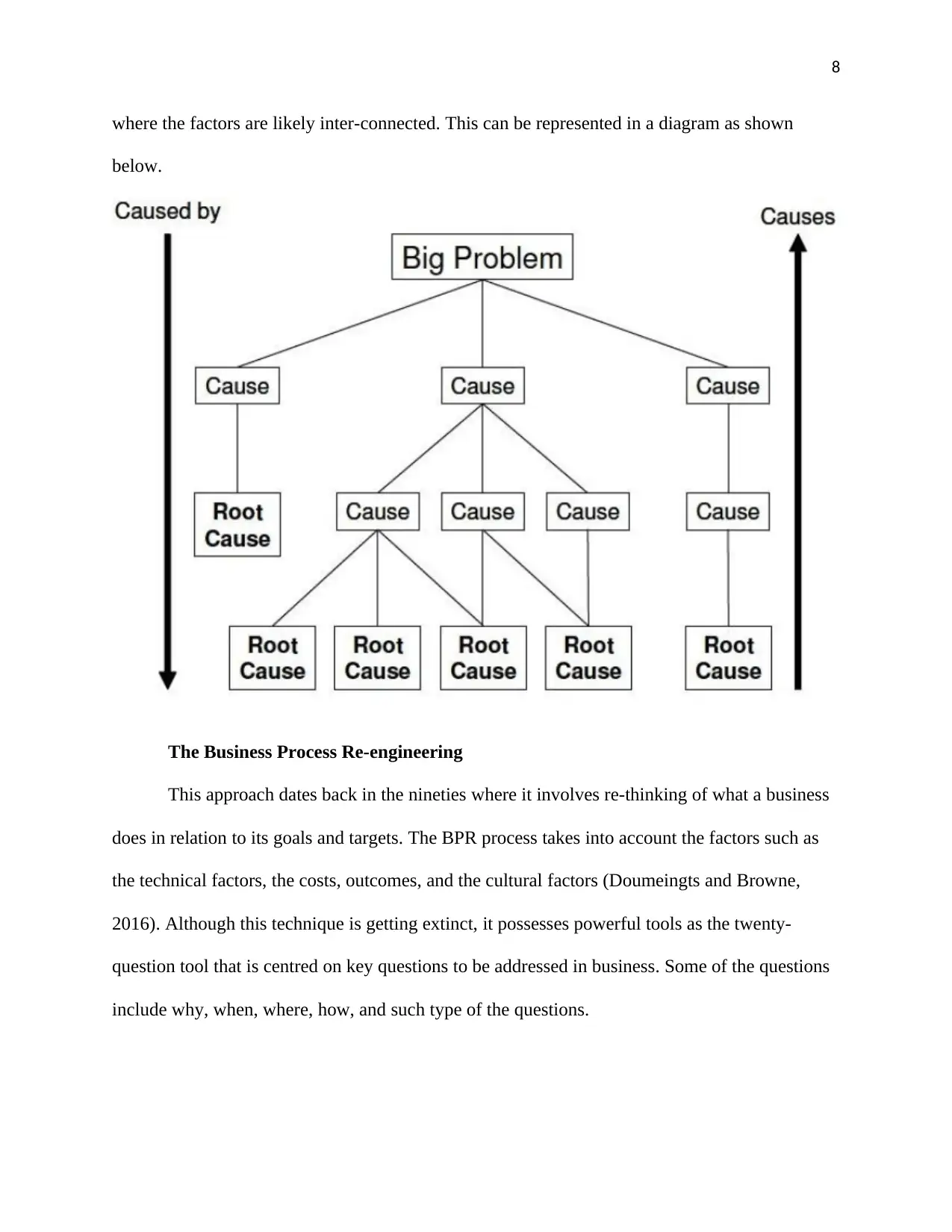
8
where the factors are likely inter-connected. This can be represented in a diagram as shown
below.
The Business Process Re-engineering
This approach dates back in the nineties where it involves re-thinking of what a business
does in relation to its goals and targets. The BPR process takes into account the factors such as
the technical factors, the costs, outcomes, and the cultural factors (Doumeingts and Browne,
2016). Although this technique is getting extinct, it possesses powerful tools as the twenty-
question tool that is centred on key questions to be addressed in business. Some of the questions
include why, when, where, how, and such type of the questions.
where the factors are likely inter-connected. This can be represented in a diagram as shown
below.
The Business Process Re-engineering
This approach dates back in the nineties where it involves re-thinking of what a business
does in relation to its goals and targets. The BPR process takes into account the factors such as
the technical factors, the costs, outcomes, and the cultural factors (Doumeingts and Browne,
2016). Although this technique is getting extinct, it possesses powerful tools as the twenty-
question tool that is centred on key questions to be addressed in business. Some of the questions
include why, when, where, how, and such type of the questions.
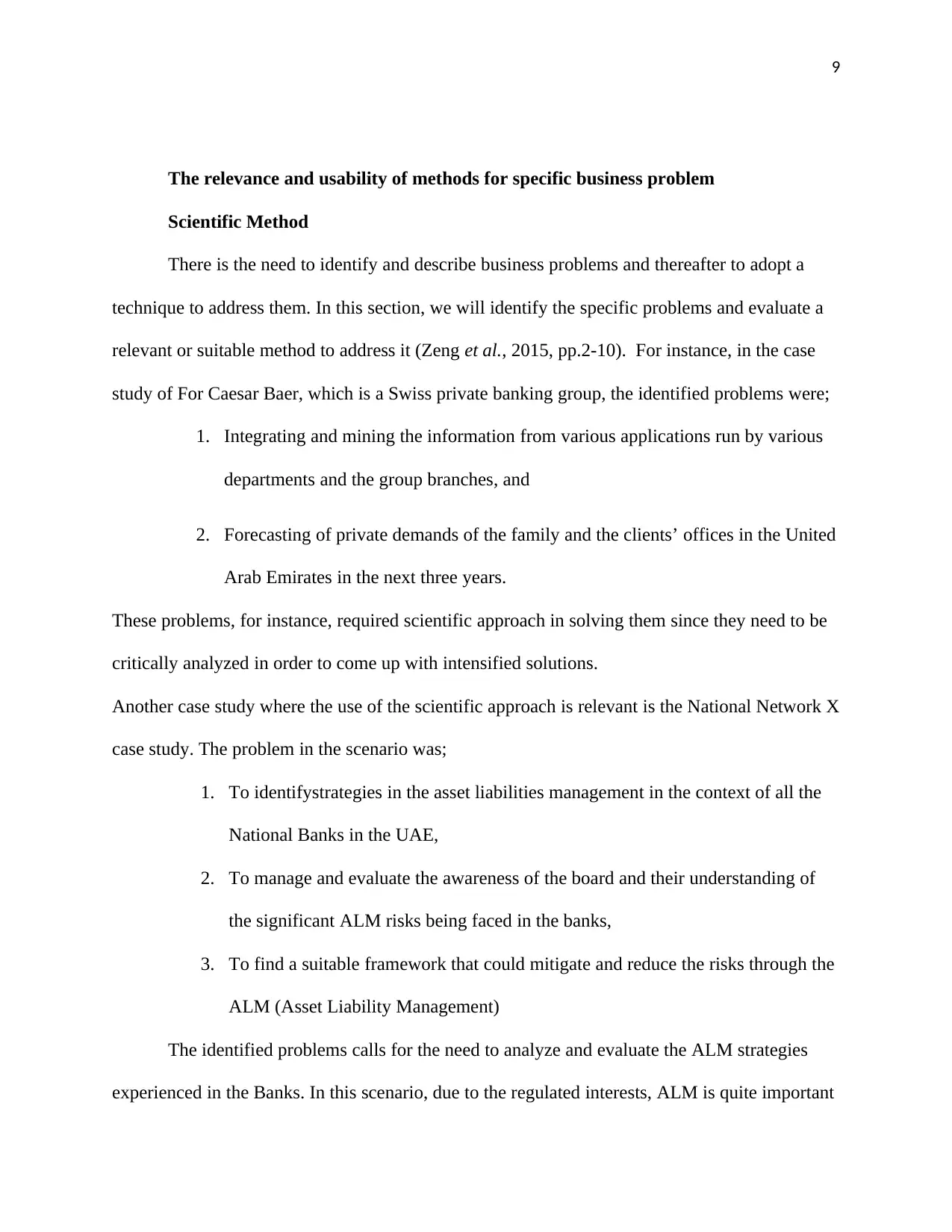
9
The relevance and usability of methods for specific business problem
Scientific Method
There is the need to identify and describe business problems and thereafter to adopt a
technique to address them. In this section, we will identify the specific problems and evaluate a
relevant or suitable method to address it (Zeng et al., 2015, pp.2-10). For instance, in the case
study of For Caesar Baer, which is a Swiss private banking group, the identified problems were;
1. Integrating and mining the information from various applications run by various
departments and the group branches, and
2. Forecasting of private demands of the family and the clients’ offices in the United
Arab Emirates in the next three years.
These problems, for instance, required scientific approach in solving them since they need to be
critically analyzed in order to come up with intensified solutions.
Another case study where the use of the scientific approach is relevant is the National Network X
case study. The problem in the scenario was;
1. To identifystrategies in the asset liabilities management in the context of all the
National Banks in the UAE,
2. To manage and evaluate the awareness of the board and their understanding of
the significant ALM risks being faced in the banks,
3. To find a suitable framework that could mitigate and reduce the risks through the
ALM (Asset Liability Management)
The identified problems calls for the need to analyze and evaluate the ALM strategies
experienced in the Banks. In this scenario, due to the regulated interests, ALM is quite important
The relevance and usability of methods for specific business problem
Scientific Method
There is the need to identify and describe business problems and thereafter to adopt a
technique to address them. In this section, we will identify the specific problems and evaluate a
relevant or suitable method to address it (Zeng et al., 2015, pp.2-10). For instance, in the case
study of For Caesar Baer, which is a Swiss private banking group, the identified problems were;
1. Integrating and mining the information from various applications run by various
departments and the group branches, and
2. Forecasting of private demands of the family and the clients’ offices in the United
Arab Emirates in the next three years.
These problems, for instance, required scientific approach in solving them since they need to be
critically analyzed in order to come up with intensified solutions.
Another case study where the use of the scientific approach is relevant is the National Network X
case study. The problem in the scenario was;
1. To identifystrategies in the asset liabilities management in the context of all the
National Banks in the UAE,
2. To manage and evaluate the awareness of the board and their understanding of
the significant ALM risks being faced in the banks,
3. To find a suitable framework that could mitigate and reduce the risks through the
ALM (Asset Liability Management)
The identified problems calls for the need to analyze and evaluate the ALM strategies
experienced in the Banks. In this scenario, due to the regulated interests, ALM is quite important
⊘ This is a preview!⊘
Do you want full access?
Subscribe today to unlock all pages.

Trusted by 1+ million students worldwide
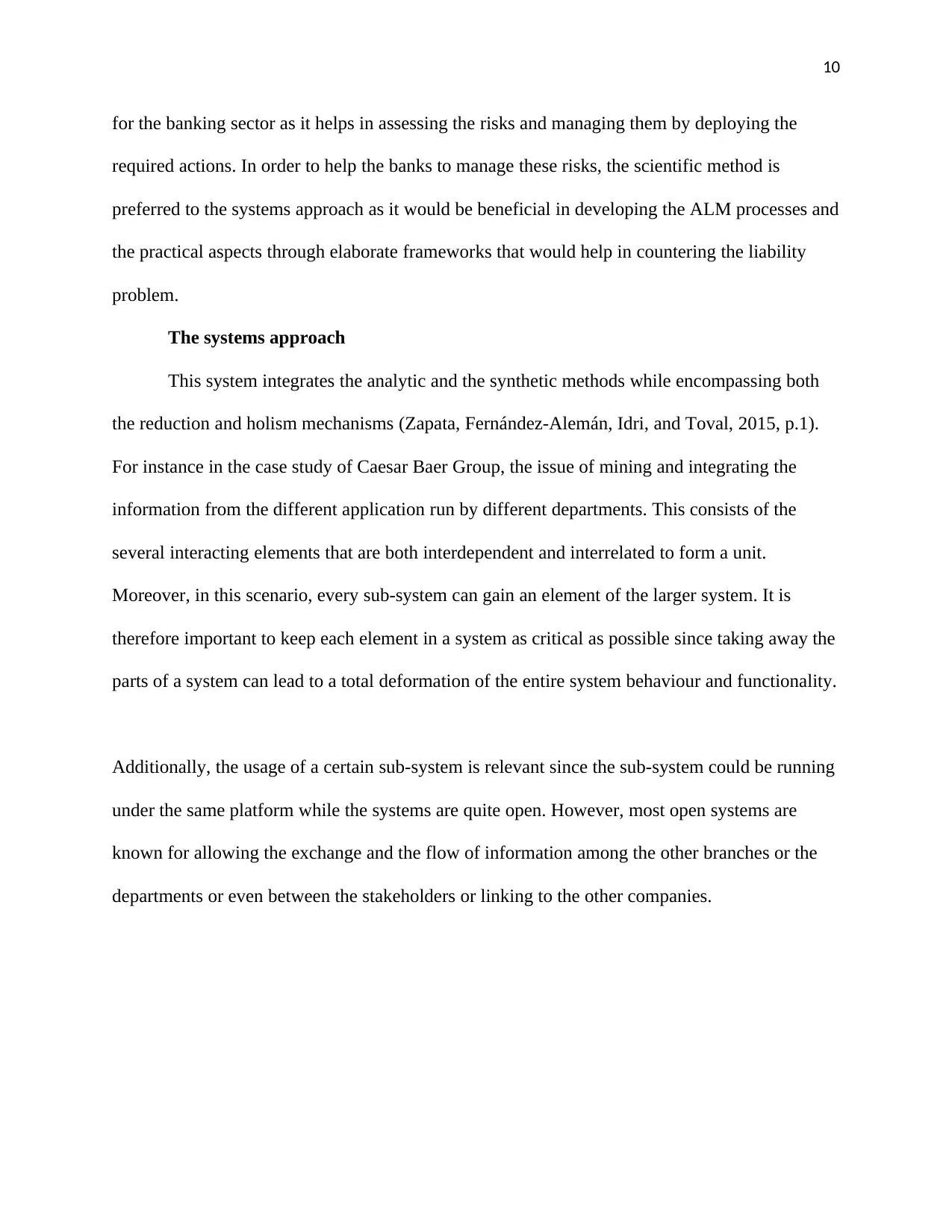
10
for the banking sector as it helps in assessing the risks and managing them by deploying the
required actions. In order to help the banks to manage these risks, the scientific method is
preferred to the systems approach as it would be beneficial in developing the ALM processes and
the practical aspects through elaborate frameworks that would help in countering the liability
problem.
The systems approach
This system integrates the analytic and the synthetic methods while encompassing both
the reduction and holism mechanisms (Zapata, Fernández-Alemán, Idri, and Toval, 2015, p.1).
For instance in the case study of Caesar Baer Group, the issue of mining and integrating the
information from the different application run by different departments. This consists of the
several interacting elements that are both interdependent and interrelated to form a unit.
Moreover, in this scenario, every sub-system can gain an element of the larger system. It is
therefore important to keep each element in a system as critical as possible since taking away the
parts of a system can lead to a total deformation of the entire system behaviour and functionality.
Additionally, the usage of a certain sub-system is relevant since the sub-system could be running
under the same platform while the systems are quite open. However, most open systems are
known for allowing the exchange and the flow of information among the other branches or the
departments or even between the stakeholders or linking to the other companies.
for the banking sector as it helps in assessing the risks and managing them by deploying the
required actions. In order to help the banks to manage these risks, the scientific method is
preferred to the systems approach as it would be beneficial in developing the ALM processes and
the practical aspects through elaborate frameworks that would help in countering the liability
problem.
The systems approach
This system integrates the analytic and the synthetic methods while encompassing both
the reduction and holism mechanisms (Zapata, Fernández-Alemán, Idri, and Toval, 2015, p.1).
For instance in the case study of Caesar Baer Group, the issue of mining and integrating the
information from the different application run by different departments. This consists of the
several interacting elements that are both interdependent and interrelated to form a unit.
Moreover, in this scenario, every sub-system can gain an element of the larger system. It is
therefore important to keep each element in a system as critical as possible since taking away the
parts of a system can lead to a total deformation of the entire system behaviour and functionality.
Additionally, the usage of a certain sub-system is relevant since the sub-system could be running
under the same platform while the systems are quite open. However, most open systems are
known for allowing the exchange and the flow of information among the other branches or the
departments or even between the stakeholders or linking to the other companies.
Paraphrase This Document
Need a fresh take? Get an instant paraphrase of this document with our AI Paraphraser
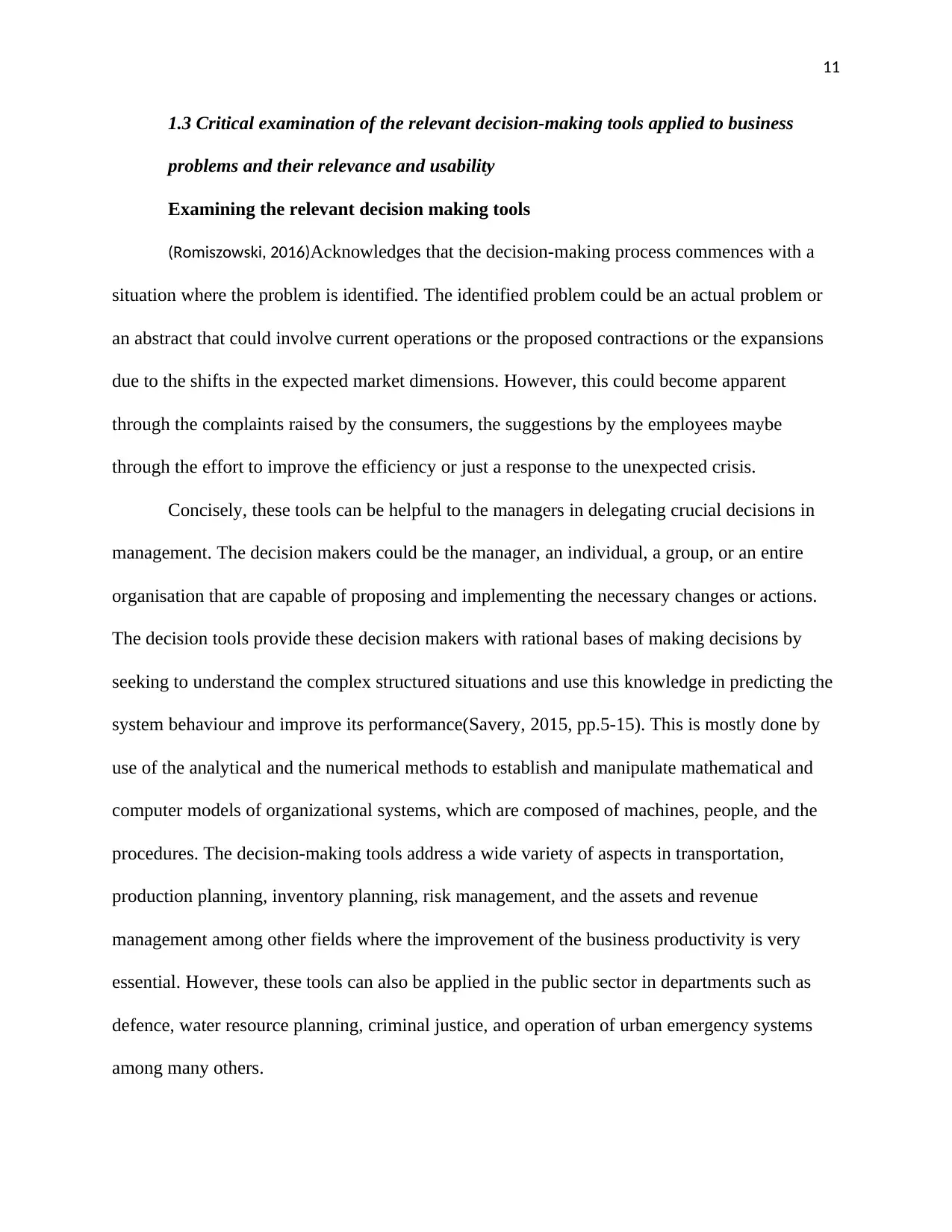
11
1.3 Critical examination of the relevant decision-making tools applied to business
problems and their relevance and usability
Examining the relevant decision making tools
(Romiszowski, 2016)Acknowledges that the decision-making process commences with a
situation where the problem is identified. The identified problem could be an actual problem or
an abstract that could involve current operations or the proposed contractions or the expansions
due to the shifts in the expected market dimensions. However, this could become apparent
through the complaints raised by the consumers, the suggestions by the employees maybe
through the effort to improve the efficiency or just a response to the unexpected crisis.
Concisely, these tools can be helpful to the managers in delegating crucial decisions in
management. The decision makers could be the manager, an individual, a group, or an entire
organisation that are capable of proposing and implementing the necessary changes or actions.
The decision tools provide these decision makers with rational bases of making decisions by
seeking to understand the complex structured situations and use this knowledge in predicting the
system behaviour and improve its performance(Savery, 2015, pp.5-15). This is mostly done by
use of the analytical and the numerical methods to establish and manipulate mathematical and
computer models of organizational systems, which are composed of machines, people, and the
procedures. The decision-making tools address a wide variety of aspects in transportation,
production planning, inventory planning, risk management, and the assets and revenue
management among other fields where the improvement of the business productivity is very
essential. However, these tools can also be applied in the public sector in departments such as
defence, water resource planning, criminal justice, and operation of urban emergency systems
among many others.
1.3 Critical examination of the relevant decision-making tools applied to business
problems and their relevance and usability
Examining the relevant decision making tools
(Romiszowski, 2016)Acknowledges that the decision-making process commences with a
situation where the problem is identified. The identified problem could be an actual problem or
an abstract that could involve current operations or the proposed contractions or the expansions
due to the shifts in the expected market dimensions. However, this could become apparent
through the complaints raised by the consumers, the suggestions by the employees maybe
through the effort to improve the efficiency or just a response to the unexpected crisis.
Concisely, these tools can be helpful to the managers in delegating crucial decisions in
management. The decision makers could be the manager, an individual, a group, or an entire
organisation that are capable of proposing and implementing the necessary changes or actions.
The decision tools provide these decision makers with rational bases of making decisions by
seeking to understand the complex structured situations and use this knowledge in predicting the
system behaviour and improve its performance(Savery, 2015, pp.5-15). This is mostly done by
use of the analytical and the numerical methods to establish and manipulate mathematical and
computer models of organizational systems, which are composed of machines, people, and the
procedures. The decision-making tools address a wide variety of aspects in transportation,
production planning, inventory planning, risk management, and the assets and revenue
management among other fields where the improvement of the business productivity is very
essential. However, these tools can also be applied in the public sector in departments such as
defence, water resource planning, criminal justice, and operation of urban emergency systems
among many others.
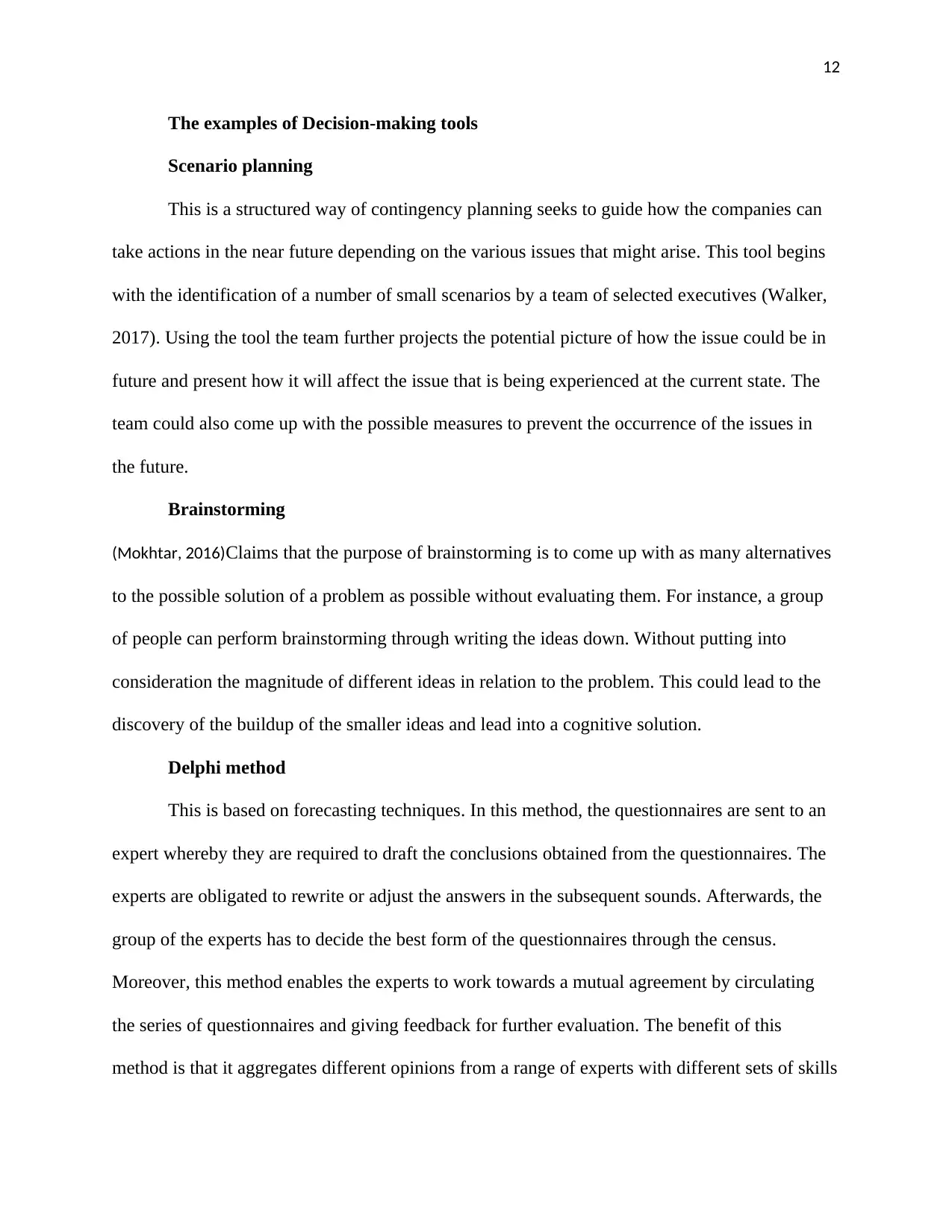
12
The examples of Decision-making tools
Scenario planning
This is a structured way of contingency planning seeks to guide how the companies can
take actions in the near future depending on the various issues that might arise. This tool begins
with the identification of a number of small scenarios by a team of selected executives (Walker,
2017). Using the tool the team further projects the potential picture of how the issue could be in
future and present how it will affect the issue that is being experienced at the current state. The
team could also come up with the possible measures to prevent the occurrence of the issues in
the future.
Brainstorming
(Mokhtar, 2016)Claims that the purpose of brainstorming is to come up with as many alternatives
to the possible solution of a problem as possible without evaluating them. For instance, a group
of people can perform brainstorming through writing the ideas down. Without putting into
consideration the magnitude of different ideas in relation to the problem. This could lead to the
discovery of the buildup of the smaller ideas and lead into a cognitive solution.
Delphi method
This is based on forecasting techniques. In this method, the questionnaires are sent to an
expert whereby they are required to draft the conclusions obtained from the questionnaires. The
experts are obligated to rewrite or adjust the answers in the subsequent sounds. Afterwards, the
group of the experts has to decide the best form of the questionnaires through the census.
Moreover, this method enables the experts to work towards a mutual agreement by circulating
the series of questionnaires and giving feedback for further evaluation. The benefit of this
method is that it aggregates different opinions from a range of experts with different sets of skills
The examples of Decision-making tools
Scenario planning
This is a structured way of contingency planning seeks to guide how the companies can
take actions in the near future depending on the various issues that might arise. This tool begins
with the identification of a number of small scenarios by a team of selected executives (Walker,
2017). Using the tool the team further projects the potential picture of how the issue could be in
future and present how it will affect the issue that is being experienced at the current state. The
team could also come up with the possible measures to prevent the occurrence of the issues in
the future.
Brainstorming
(Mokhtar, 2016)Claims that the purpose of brainstorming is to come up with as many alternatives
to the possible solution of a problem as possible without evaluating them. For instance, a group
of people can perform brainstorming through writing the ideas down. Without putting into
consideration the magnitude of different ideas in relation to the problem. This could lead to the
discovery of the buildup of the smaller ideas and lead into a cognitive solution.
Delphi method
This is based on forecasting techniques. In this method, the questionnaires are sent to an
expert whereby they are required to draft the conclusions obtained from the questionnaires. The
experts are obligated to rewrite or adjust the answers in the subsequent sounds. Afterwards, the
group of the experts has to decide the best form of the questionnaires through the census.
Moreover, this method enables the experts to work towards a mutual agreement by circulating
the series of questionnaires and giving feedback for further evaluation. The benefit of this
method is that it aggregates different opinions from a range of experts with different sets of skills
⊘ This is a preview!⊘
Do you want full access?
Subscribe today to unlock all pages.

Trusted by 1+ million students worldwide
1 out of 24
Related Documents
Your All-in-One AI-Powered Toolkit for Academic Success.
+13062052269
info@desklib.com
Available 24*7 on WhatsApp / Email
![[object Object]](/_next/static/media/star-bottom.7253800d.svg)
Unlock your academic potential
Copyright © 2020–2025 A2Z Services. All Rights Reserved. Developed and managed by ZUCOL.




